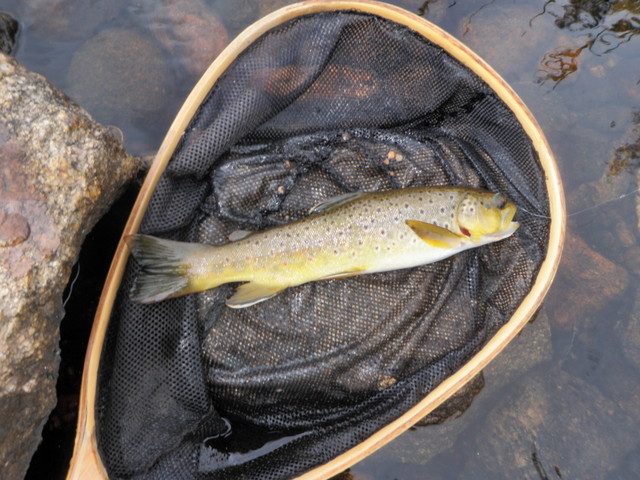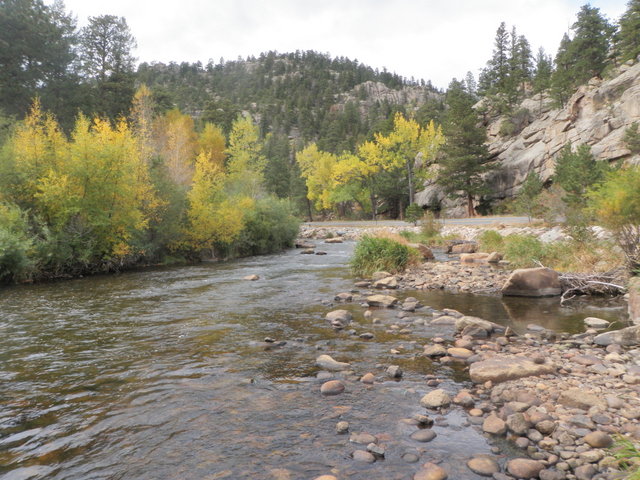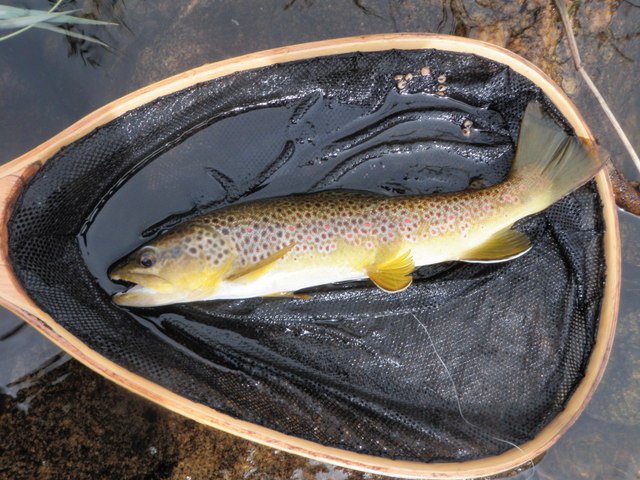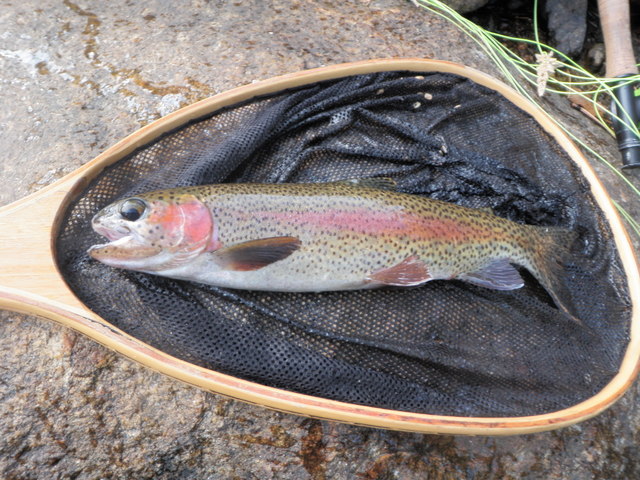Time: 12:30PM – 4:30PM
Location: First bridge after Noel’s Draw and then upstream across from a small pullout where the river widens after a series of cabins and private property
Fish Landed: 13
Big Thompson River 09/25/2012 Photo Album
I arrived at work to present August results at the staff meeting, but after the operations meeting John informed me that Luke had to leave and there would be no meeting on Tuesday. I told John I didn’t have work, so I planned to be out the remainder of the week, and he was fine with that.
I returned home and rounded up my fishing gear and departed for the Big Thompson. It was quite overcast with periods of light rain as I left, so I was hoping to encounter an afternoon BWO hatch. The Big Thompson is closer than other possible destinations, the flows were around 50, and the reports from the fly shops were favorable. I pulled out of the garage around 10:30 and arrived at the pullout just before the first bridge after Noel’s Draw at around noon. I munched my lunch next to the stream and observed, but didn’t see any significant insect activity. It was around 65 degrees so I wore my raincoat for warmth.
I walked across the bridge and began fishing below the first downstream bend. I began with a muggly caddis as this is a nice large searching pattern that floats well and rides low in the surface film. It didn’t take long before a decent rainbow tipped up and sucked in the caddis. I picked up two small browns and another rainbow before reaching the bridge, and I was feeling pretty good about the day so far. The fish weren’t jumping on the muggly, but it was producing at a reasonable pace. On the other side of the bridge, however, I began to experience refusals so I swapped the muggly caddis for a light gray size 16 deer hair caddis. This enabled me to add another brown to my fish count, but then it also started generating refusals.
Perhaps the fish would be more interested in something subsurface? I clipped off the caddis and tied on a parachute hopper and then added a beadhead baetis wet fly that I tied from Charlie Craven’s book. Immediately two fish hammered the trailer, and I thought I’d solved the riddle. But that was it, and I experienced a period of no action even though I experimented with different drifts and imparted motion. It was around this time that an SUV pulled into the spot behind my car and two fishermen emerged and began climbing into their waders. Sure enough after a few minutes I looked upstream and saw the two fishermen on the bank along the road fishing the water I was headed toward.
As I moved within 30 yards of the lower fisherman, I reeled up my flies and clipped them to the rod guide, and then crossed the river and returned to the Santa Fe. I decided to head back upstream and try some new water, so I drove along slowly. The first pullout had a car and fishermen, but I grabbed the next one on the right side of the road opposite the river. Before charging down to the stream, I added a fleece layer and a stocking hat as the sky was getting quite dark and the wind kicked up.
I walked down the shoulder of the road to a private no trespassing sign and then dropped down the bank and began fishing where the river was wide with numerous wide shallow riffles. As I couldn’t entice any strikes on the hopper or BWO wet fly imitation, I removed them and tied on a large tan body elk hair caddis. I prospected this for a bit and generated a refusal or two, and then decided to add a beadhead RS2 in case the approaching storm got the fish active on nymphs. This once again was a good thought process, but it didn’t produce any success.
It was now around 3PM and the wind began to gust, and I began to notice some subtle rises in the soft water along the south bank. I strained my eyes to look more closely and noticed some BWO’s riding on the surface unless they got lifted into the air by a gust of wind. I quickly changed to a CDC BWO from my patch and deftly placed some casts over the fish. My tiny tuft of a fly which usually produces magically was being ignored. I decided to place my net in the water and seine for naturals, and when I lifted the net discovered two mayflies clinging to the fine webbing. I picked one up with my fingers and it was even smaller than my size 22 flies; probably a size 24.
I pulled out my fly box and searched until I found the smallest body visible and tied this on to my line. Sure enough this fly began to produce as I moved above the area of the feeding fish and made some nice downstream presentations. Between 3 and 4 PM I landed four nice trout, two browns and two rainbows by making downstream drifts to locations where I spotted rises. These fish were the nicest fish I landed on the day with bright colors and measuring mostly 12 -13 inches. I kept walking or wading upstream and looking for small pools with rising fish and then executed downstream presentations to the spotted fish. When the sun broke through the clouds, the sun glare was quite difficult from below, but positioning above and casting across and down solved this difficulty. I also had three or four momentary hookups where I didn’t land the fish.
Unfortunately by 4PM the hatch ended, but I continued upstream looking for occasional rising fish. I was now high on the bank next to the road and approached a very deep hole where I spotted at least four fish. Several were playing the territorial game with a larger fish chasing away a smaller intruder. But I also saw a nice sized fish further out at the very top of the hole where a riffle dropped off to the deeper water, and I decided to try for this guy. I made some downstream drifts with the CDC BWO to no avail, but then decided to try the light gray caddis since the BWO hatch was essentially defunct. On the third or fourth downstream drift of the caddis I saw a flash and set the hook and landed a nice and brilliantly colored rainbow of around 13 to 14 inches.
On this note I ended my day and made the drive back to Denver. Tuesday evening I tied five size 24 CDC BWO’s so I’m prepared for the next encounter with this tiny hatch.




